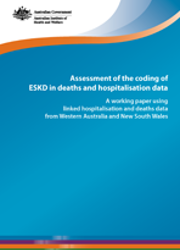Summary
End-stage kidney disease (ESKD), the most severe form of chronic kidney disease (CKD), usually requires kidney replacement therapy (KRT) for patients to survive. Monitoring the impact of ESKD is important in planning for the future health needs of the population. One way to monitor the impact in Australia is to count the number of patients who receive KRT for their ESKD by using registry data and to some extent hospital data. But it is also important to identify people with ESKD who do not receive KRT, which can be done through analyses of hospital and mortality data.
This study aimed to assess the likelihood that a patient who is hospitalised with ESKD will have ESKD recorded on their death record. This will help to establish whether mortality records in Australia reflect the actual disease pattern of people with ESKD.
Linked hospitalisation and deaths data from NSW and WA were used to assess the level of agreement between the recording of ESKD in hospitalisation and deaths data. Agreement was assessed in both directions: forwards direction: (hospital→death agreement); and backwards direction: (death→hospital agreement). Additional analyses were performed estimating the time to death for both KRT-treated and non-KRT-treated patients.
Key findings
Agreement between the hospitalisation and death records of ESKD presence was relatively poor in both directions in WA and NSW:
- In WA (between 1 July 2008 and 31 December 2010), using the most recent and current definition of ESKD status:
- 69% of people with an ESKD hospitalisation did not have ESKD in their death record (forward direction).
- 40% of people with ESKD recorded in deaths data did not have an ESKD diagnosis in their hospitalisation records (backward direction).
- In NSW (between 1 July 2000 and 31 December 2007) the corresponding proportions were 88% (forward direction) and 23% (backward direction) for people aged 40 and over.
The agreement between hospital and mortality records did not vary by age in the forward direction but did in the backward direction. In WA, the proportion of people who had an ESKD cause of death but no corresponding ESKD hospitalisation was much higher in older age groups.
The data also showed that non-KRT-treated cases have a much shorter time to death than KRT-treated cases (median: 8 versus 799 days). Therefore, death date appears to be a good proxy for incident date (based on first hospitalisation) for non-KRT-treated cases.
Conclusion
This study confirms that the ESKD codes used in the mortality data to estimate ESKD incidence are conservative and therefore likely to underestimate the impact of ESKD. The results suggest that there is a high proportion of patients who are hospitalised with ESKD but do not have ESKD on their death certificate. However, it is not certain that everyone treated for ESKD is treated in hospital. Further linkage to the Australia and New Zealand Dialysis and Transplant (ANZDATA) Registry would help capture data on people treated with KRT outside hospitals.



